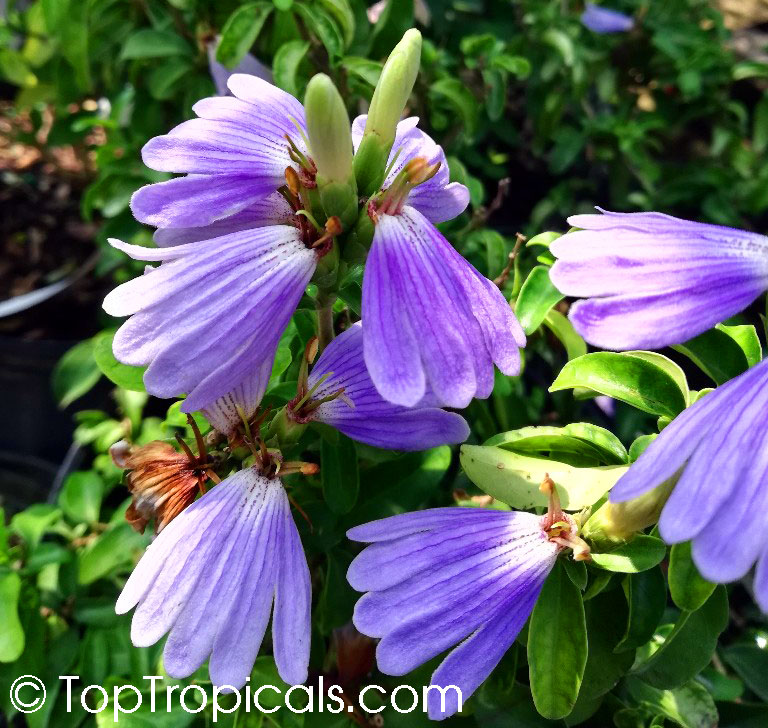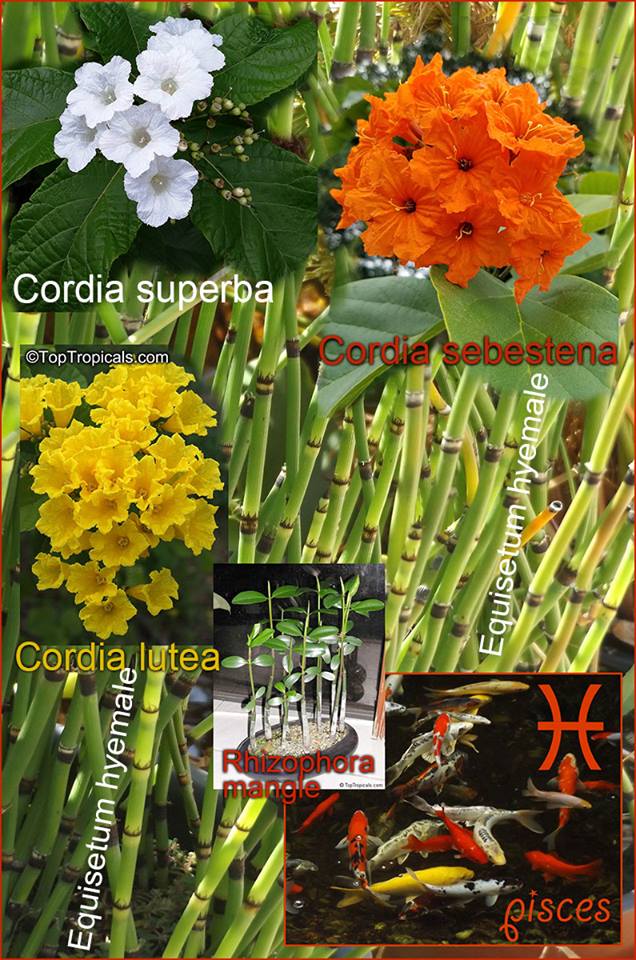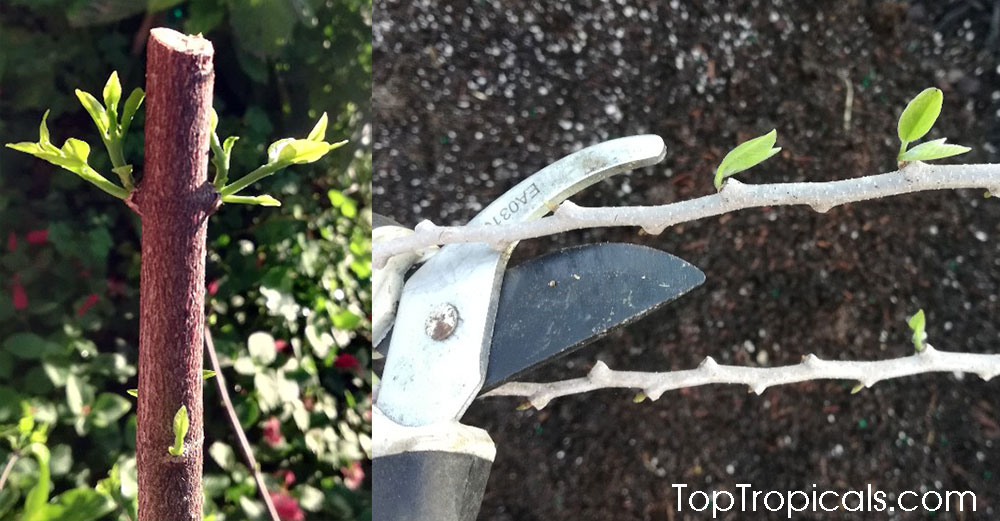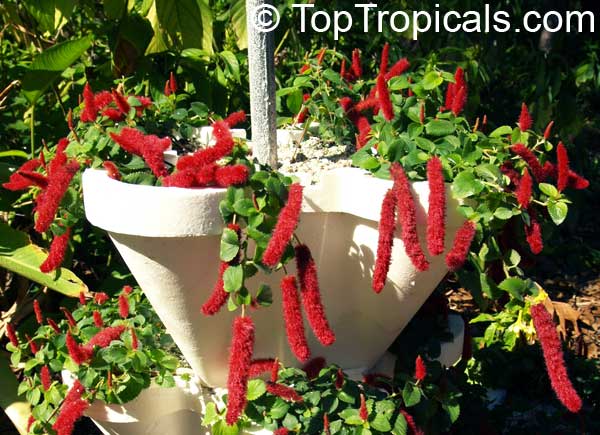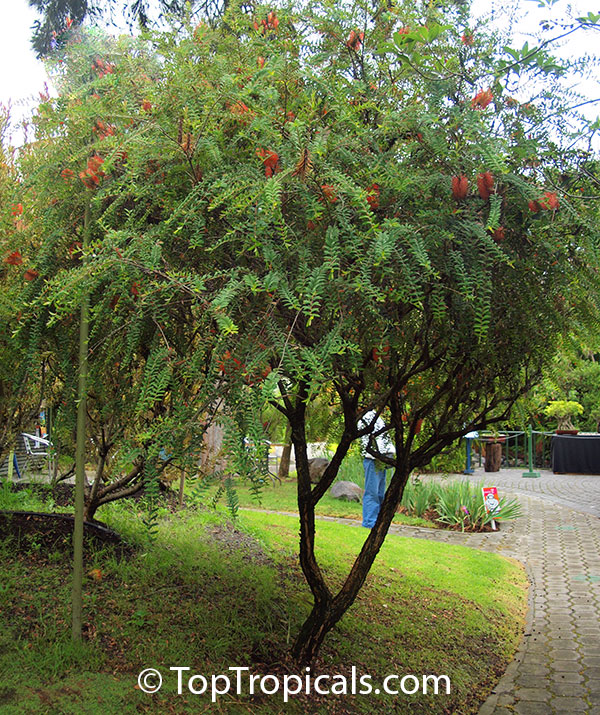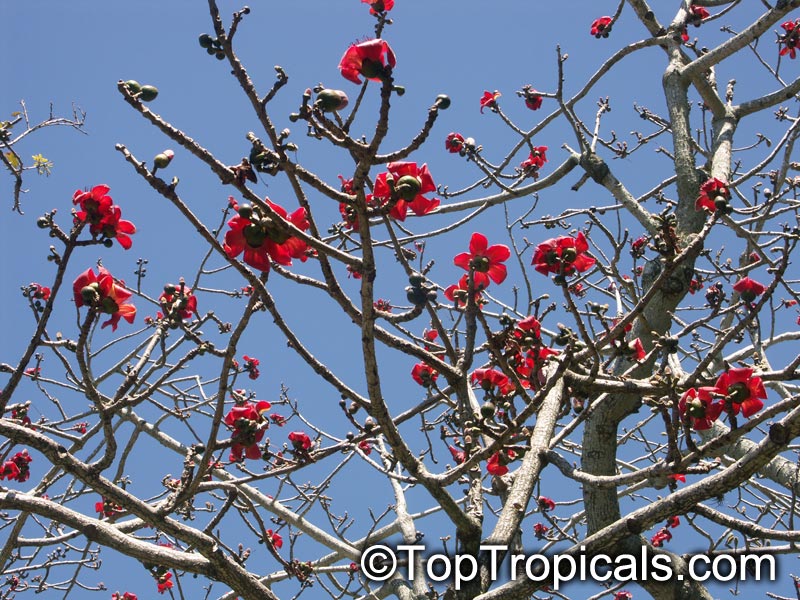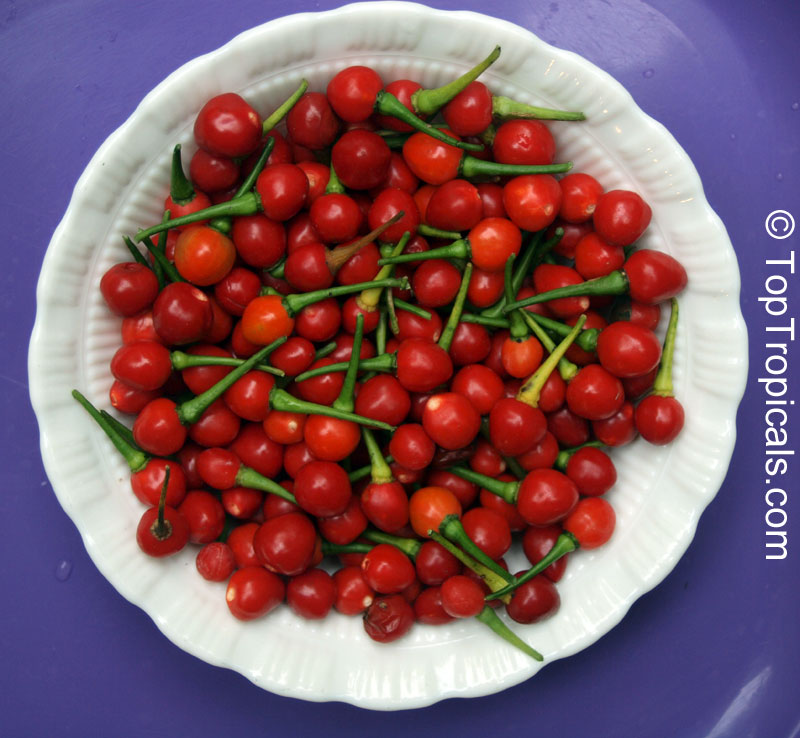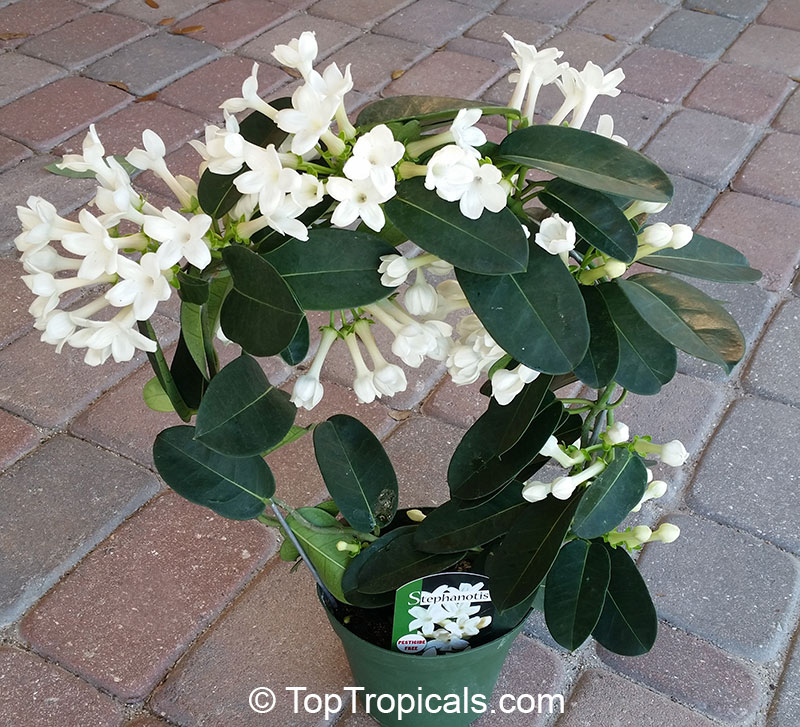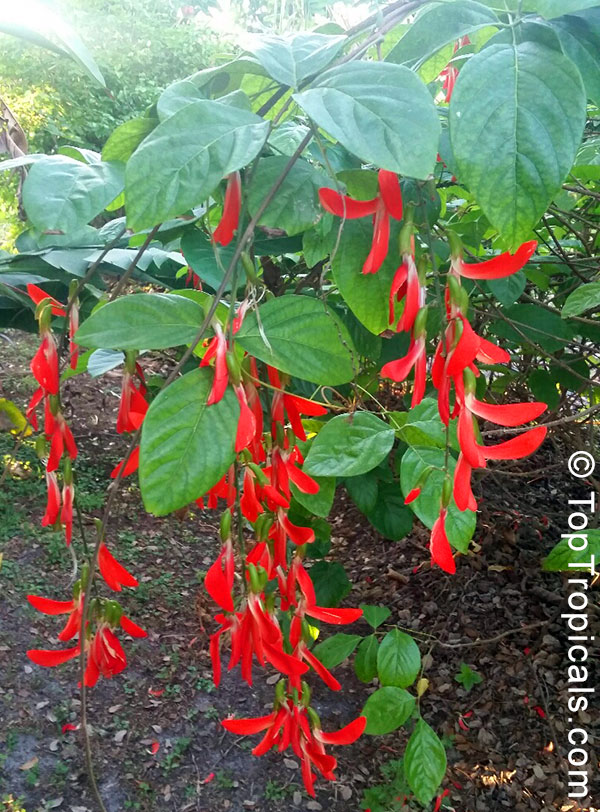Garden Blog - Top Tropicals
Date:
Surprising Violet fragrance of the Blue Lips
By Mark Hooten, the Garden Doc
 A few months ago while working among the bewildering array of great plants
we grow, I began to notice wafts of a very unique fragrance. The scent seemed
somehow familiar, yet for the longest time, I was unable to determine what
kind of plant it was emanating from. I knew it was somewhere toward the back
of the growing houses but just couldn't determine its source. The fragrance is
very distinct and wonderful and could be detected over a large area... That
scent is hard to describe, however, I would suggest a mixture of Lavender and
old-fashioned florist violets...
A few months ago while working among the bewildering array of great plants
we grow, I began to notice wafts of a very unique fragrance. The scent seemed
somehow familiar, yet for the longest time, I was unable to determine what
kind of plant it was emanating from. I knew it was somewhere toward the back
of the growing houses but just couldn't determine its source. The fragrance is
very distinct and wonderful and could be detected over a large area... That
scent is hard to describe, however, I would suggest a mixture of Lavender and
old-fashioned florist violets...
Then, a few weeks later, I happened to lean over a grouping of Sclerochiton plants, and THERE IT WAS!!! This might be the first flowering plant I have encountered which I might rate a full 10...
Date:
Pisces Zodiac lucky plants

Pisces- 2/19 -
3/20. As a WATER sign ruled by both Jupiter and Moon (and Neptune, that
was not discovered until 1846, after the plant correspondences were
established; Neptune is considered a "higher octave" of the Moon), Pisces plants are
often large but hard to find, and may grow near the ocean. The most healing
plants for Pisces are those that strengthen the immune system or have an
antibacterial effect. Pisces plants may also catalyze expanded states of awareness
and be helpful in dream work.
Herbs connected to Pisces are ruled by its former ruler, the Moon
(Neptune, the current ruler, was not discovered until 1846, after the plant
correspondences were established; Neptune is considered a “higher octave†of
the Moon). Diseases of Pisces have traditionally included psychotic disorders,
various forms of substance addiction, lung diseases such as tuberculosis, and
ailments of the foot; contemporary herbalists also add immune system
diseases. Pisces is strengthened by rosemary's ability to promote an aura of
centered grounding. This protective herb helps strengthen boundaries and cultivate a
closer connection to the physical realm.
Pisces Zodiac
lucky plants: Water lily, Lotus, Clematis, Wisteria, Lisianthus, Brunfelsia, Echinacea, English Lavender, Rosemary, Coconut palm, Cranberry, Clove, Coccoloba, Sea Oats, Mangroves, Ochrosia, Aquatic plants, Colocasia, Alocasia, Aralia, Ficus trees, Banyan, Peepal, Banana, Mango, Mimosa, Olive, Anise, Vilca and Yopo, Kava-kava, Nutmeg, Anthuriums, Eucalyptus, Bauhinia,
Clusia, Caesalpinia, Callistemon, Bucida, Cassia fistula, Cordia, Calabash, Lipstick palm, Delonix, Elaeocarpus, Erythrina, Fatsia, Guaiacum, Mahoe, Koelreuteria, Kopsia, Macaranga, Pandanus, Peltophorum, Psychotria, Banesteriopsis, Tabebuia.
For other signs information, see Plant Horoscope Page.
Date:
To prune or not to prune?
Q: We had a few nights with light frost and some of my tropical plants look sad, lost all leaves. I scratched the bark and it is green inside. Should I prune back all branches that look dead?
A: Never prune during winter time, even if some branches look dead. There is a chance you will be surprised by Spring when they sprout new leaves. Be patient and postpone all pruning until active growth starts, then cut off only damaged part, approximately 2" above new growth.
Date:
Featured plant. Acalypha pendula, Dwarf Chenille Plant
Strawberry Firetails, Dwarf Cat Tails, Kittens Tail...
Everybody wants this plant! Acalypha pendula, Dwarf Chenille Plant gets
its common name from the fuzzy plumes of tiny, foxtail-shaped bright red
flowers that trail above a thick mound of small, serrated leaves. Given enough
light, this plant blooms nearly year-round! The blossoms that begin as wispy
buttons and elongate into fuzzy cones. At maturity, they become 3-4" long
streamers.
A spectacular plant for a hanging basket, container or ground cover, it
is heat tolerant, great for both hot Southern landscapes or as an easy
houseplant, providing bright light.
Place this unusual house plant on a pedestal stand or pot it in a hanging
basket to show off those eye-catching fuzzy blooms.
This is a dwarf plant that stays small and doesn't need pruning. It's
naturally bushy, so you don't have to pinch its growing tips to get it to
branch out.
A favorite with children, and cats too!
Date:
Australia Planting 1 Billion Trees To Fight Climate Change
Australia plans to plant 1 billion new trees to fight climate change, by
the year 2050. That is a lot of trees and is the first real effort the
country has made toward combating climate change. The only real problem is finding
enough space to plant that many trees...
A billion trees is a billion trees, and even with a team of 30,000
people planting a tree per day for the next 31 years, the final tally would still
only be 339,450,000 trees. Australia will need a tree army to get that many
trees planted by 2050... Read the whole story...
How about planting just one tree today and save the World one step at a time?
On the photo: Callistemon, Australian native tree.
Date:
Featured plant. Randia formosa - Blackberry jam fruit
Randia formosa - Blackberry jam fruit
This unique compact plant, perfect for container culture, combines features of a fragrant flower and tasty desert fruit. Kids love it! Originally from Central and South America, this rare tropical small evergreen tree bears fruit which tastes like fresh Blackberry jam. Many claim that it's even better than preserves. Closely related to the gardenia, its flowers are sweetly fragrant. This relatively hardy tropical has attractive foliage and can be grown in a container as well as in the ground. The Randia formosa (or Rosenbergiodendron formosum) produces as many as 25 to 30 fruits at a time. Since it blooms for a few months in the fall and winter, fruiting and flowering can be enjoyed when many other plants are dormant. Large tubular white flowers that attract nocturnal moths... Read more about this plant...
Date:
Deciduous plants soon sprouting
Many people believe that living in a warm climate will dissuade a plant from its deciduous nature. However, deciduous plants react to not only temperate but also shortened hours of daylight and changes in precipitation. Additionally, some plants will drop foliage in phases between new growth, and others use abscission to aid in pollination; blooming without wind-blocking leaves and making flowers more visible for insects.
When pruning a deciduous tree or shrub, it's generally best to wait until late winter or early spring, before the plant begins to leaf out. Avoid pruning during periods of new growth; during this time, the plant is weakened by the struggle to reestablish its growth process. Before pruning your deciduous plant, first research the specific plant, as there will always be exceptions to general instruction. For example, many Rubus varieties desire to prune in late fall, as their buds are developed during the dormant winter season. Some trees may have flower or fruit during winter while having no leaves, give them a chance to flower before pruning.
On the photo: Winter flowering Bombax ceiba in full bloom.
Date:
Featured plant. Capsicum frutescens - Wiri Wiri Pepper
Capsicum frutescens - Wiri Wiri Pepper
A variety from Guyana, the Wiri Wiri pepper is the illustrious gem; hard
sought and rarely found. This plant produces good yields of small 1/2" berry
shaped hot peppers. Peppers grow upright, are very hot, and turn from green,
to orange, to red when mature.
What makes it so much different than any other hot pepper grown in the
garden or bought at the store?
Hot? Yes, it is important that hot peppers are, but the people who
really know, know that it is not just about heat, it is about flavor! And that is
exactly what makes this little red gem so special. Guyanese dinners will
only take one of those meals for you to never forget! The secret of their food
is the flavor, and one of the cornerstone ingredients in many of their dishes
is the Wiri pepper. The Guyanese population claim that it is not just a key
ingredient to their diet, but also to why they are so good looking, live so
long and have such great skin.
Date:
Lovely Madagascar Jasmine (Stephanotis)
By Mark Hooten, the Garden Doc
 Question: Could you recommend an easy to grow flowering vine for a
large trellis? Something with a sweet fragrance?
Question: Could you recommend an easy to grow flowering vine for a
large trellis? Something with a sweet fragrance?
Answer: Personally, I have to consider the "Madagascar Jasmine" (Stephanotis) as being one of my favorite flowering vines. I used to grow one as a windowsill-plant in Indiana when I was just a kid. Even indoors in the far north, (wrapping itself around a small home-made bamboo trellis), it somehow managed to reliably flower off and on all year long, even in mid-winter... Continue reading...
Date:
Featured plant.Camptosema grandiflora - Dwarf Red Jade Vine
Camptosema grandiflora - Dwarf Red Jade Vine
Dwarf Red Jade vine. If you always wanted to own THE Red Jade Vine, here is your chance! Also called Cuitelo, Crista-De-Galo (Rooster's Crest), it is sometimes miss-identified as a Mucuna species. This amazing eye-catcher is closely related to Red Jade Vine, however, it is much hardier than the ultra-tropical Mucuna benettii! It is a spectacular fast-growing vine from Brazil with long pendulous chains of fiery bright red flowers. Heavy vine, it needs large trellis or pagoda. An arbor is ideal so that the brilliant flowering racemes can hang down from the ceiling. Blooms in fall and winter. Prune heavily in spring after flowering. Give full or partial sun with adequate moisture and fertilizer. It is very easy to grow, can tolerate some drought and light frost.
